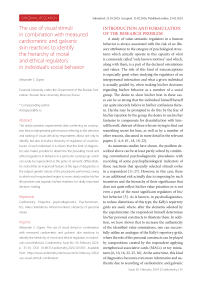The use of visual stimuli in combination with measured cardiometric and galvanic skin reactions to identify the hierarchy of moral and ethical regulators in individual’s social behavior
Автор: Ognev A.S.
Журнал: Cardiometry @cardiometry
Рубрика: Original research
Статья в выпуске: 30, 2024 года.
Бесплатный доступ
The article presents experimental data confirming an assump-tion that an independent performance referring to the selection and ranking of visual stimuli by respondents allows not only to identify, but also to build a hierarchy of regulators of social be-havior of each individual. It is shown that this kind of diagnos-tics also makes possible to determine the prevailing moral and ethical regulators in behavior in a particular social group, which can easily be represented as the poles of semantic differentials. It is noted that an important feature of this type of diagnostics is the subject-genetic nature of the procedures performed, owing to which each respondent begins to more clearly realize his/her life priorities and expands his/her readiness for vitally important decision-making.
Cardiometry, projective psychodiagnostics, psychomemantics, value orientations, moral incentives, hierarchy of personal values
Короткий адрес: https://sciup.org/148328270
IDR: 148328270 | DOI: 10.18137/cardiometry.2024.30.5561
Текст научной статьи The use of visual stimuli in combination with measured cardiometric and galvanic skin reactions to identify the hierarchy of moral and ethical regulators in individual’s social behavior
Imprint
Alexander S. Ognev. The use of visual stimuli in combination with measured cardiometric and galvanic skin reactions to identify the hierarchy of moral and ethical regulators in individual’s social behavior. Cardiometry; Issue No. 30; February 2024; p. 55-61; DOI: 10.18137/cardiometry.2024.30.5561; Available from: use-visual-stimuli-combination
INTRODUCTION AND FORMULATION OF THE RESEARCH PROBLEM
A study of value-semantic regulators in a human behavior is always associated with the risk of an illusory attribution to the category of psychological structures which actually operate in this capacity of what is commonly called “only known motives” and which, along with them, is a part of the declared orientations and values. The risk of this kind of misconceptions is especially great when studying the regulators of an interpersonal interaction and what a given individual is actually guided by, when making his/her decisions regarding his/her behavior as a member of a social group. The desire to show his/her best in these cases can be so strong that the individual himself/herself can quite sincerely believe in his/her confusions therein. He/she may be prompted to do this by the fear of his/her rejection by the group, the desire to use his/her fantasies to compensate for dissatisfaction with him-self/herself, distrust of those who are trying to find out something secret for him, as well as by a number of other reasons, discussed in more detail in the relevant papers [1-4, 6-10 , 18, 19, 22].
As numerous studies have shown, the problem described above can be at least partly solved by combining conventional psychodiagnostic procedures with recording of some psychophysiological indicators of those reactions that specially selected stimuli evoke in a respondent [11-27]. However, in this case, there is an additional risk actually due to imposing by such incentives and the hierarchy of their significance that does not quite reflect his/her value priorities or is not even a part of the most significant regulators of his/ her behavior [5]. As is known, in psychodiagnostics, to reduce distortions of this type, the Kelly’s repertory grids are used, where, after the elements selected by the experimenter, the respondent himself determines his/her personal constructs to illustrate them. In addition, we have shown that to increase the authenticity of the identified value orientations, one can successfully utilize an analogue of the Kelly’s repertory grids, where the role of the personal constructs can be played by compositions created by the respondent applying metaphorical associative cards (MACs) or toy miniatures [6, 10, 16, 22, 25, 26]. At the same time, this kind of diagnostics becomes even more informative and authentic due to recording of cardiometric and galvanic skin data of the psychophysiological reactions by the test subjects to the designations or the symbols of his/ her own values chosen by him/her [22, 25, 26]. All this supports the basis for the assumption that it is possible not only to identify, but also to build a hierarchy of such regulators of the behavior of a particular individual. To test this hypothesis, a research program has been developed and implemented, the content and the results of which are the subject of this research work.
EXPERIMENTAL PROCEDURE
Taking into account the assumption made, 12 different sets of associative metaphorical cards were used as stimulus material, containing a total of about a thousand different images. In this case, the purposeful redundancy allows each test subject to determine what exactly he/she would like to use to indicate his/her associative connections between a certain visual stimulus and what he/she considers to be the most important moral and ethical norm regulator in his/her social behavior. At the beginning, each test subject made his/ her choice in four stages. At first, he/she was given a possibility to look through each of the proposed card sets and choose the one which, in his/her opinion, was most suitable for solving the task in question. Then he/ she had to select at least five metaphorical associative cards to personify for him/her the most significant moral and ethical principles which served him/her as regulators in relationships with other people. Next, for each of the selected metaphorical associative cards, the respondent selected its antipode, which, in his opinion, personified something diametrically opposed. As a result from such a paired selection, each of the important moral and ethical norms identified by the respondent was displayed in the form of two semantic poles of a kind of the visual semantic differential. After that, the respondent demonstrated the hierarchy of the moral and ethical regulators of his/her social behavior that he had designated by ranking the pairs of the metaphorical associative cards he/she had chosen according to the degree of their significance and the power of their influence on the decisions he/she made and the actions he/she performed.
Upon completion of the ranking, each respondent was asked to retain exactly five pairs of the metaphorical cards as the most significant regulators of his/her social behavior. The remaining pairs for their further presentation, when working with a cardiometer and a polygraph, were to be laid out in such a way that in 56 | Cardiometry | Issue 30. February 2024
the middle, i.e. in the third position, there was the one that was subjectively most significant for the respondent, in the second and third positions there were the most significant of the four remaining ones, in the first and fifth positions there were the least significant of all the five. We considered the first and last pairs as those sacrificial relevant ones in the logic when sacrificial questions were placed in similar positions during conventional polygraph tests [3]. The second, third and fourth pairs formed in each tested set a kind of visually relevant significant stimuli, the reaction to which was recorded and taken into account as a result of the measurement part of the study as a mandatory procedure.
After ranking, each individual metaphorical associative card included in the hierarchical selection was presented in turn to the respondent who created it. He/ she was asked to focus his/her attention on the current card and think about the degree of its significance, what emotions it evoked, what bodily sensations appeared at the same time and what actions by him/by her all that stimulated. In parallel with that, a cardiogram was produced and the electro-dermal activity (EDA) of the respondent was recorded. PC-assisted cardiometers Cardiocode and polygraphs Barrier-14 and KRIS were applied as measuring devices in our study. In the first case, special attention was paid to the stress index automatically determined by the above cardiometer, calculated according to the Baevsky method. In the second case, the area under the curve of the chronological graph of the respondent’s galvanic skin response data was used as the main indicator of the EDA intensity, taking into account the time interval, when the attention was fixed on the current visual stimulus.
The measurement results were subsequently subjected to statistical processing, which was carried out using the licensed statistical package STADIA 8.0/ huge. During this processing, descriptive statistics were determined: first of all, arithmetic mean values and medial values of those parameters that were recorded for the entire group of respondents during cardiometric and galvanic skin measurements. An exploratory factor analysis of latent relationships calculated using the same statistical package of rank correlation coefficients was also performed. Despite the fact that comploratory factor analysis was initially envisaged and that it was fundamentally possible, at the final stage none of the variants of comploratory factor analysis was completed for the reasons stated in the descriptive part and in the part of the discussion of the results herein.
A total of 73 respondents aged 18 to 48 years participated in the study. A third of the respondents were men, the rest were women without any indication or declaration of non-traditional sexual orientation. A detailed post-test conversation was conducted with each participant individually, the principles and features of which are described in detail in the papers [11-13, 18, 24, 26, 27].
RESULTS AND DISCUSSIONS
As expected, the most intense psychophysiological indicators for the majority of respondents were recorded for the third pair of stimuli, which they themselves chose as the most significant moral and ethical regulator of their social behavior. An example Figure given below herein shows photographs taken by the test subjects themselves, voluntarily made available to us, where the top rows of the metaphorical cards correspond to selected visual illustrations of such regulators. The bottom rows of the metaphorical associative cards in all the presented Figures correspond to the subsequent selection of the respective antipodeal card for the card referred to the top row. Each of the following photographs was also taken by the originator of the corresponding composition and, of his/her own free will, was made available to the researchers.

Figure 1. An example of selection of visual personifications of moral and ethical regulators in social behavior. In the photograph taken and voluntarily put at our disposal by the respondent himself/herself, the top rows of the metaphorical cards correspond to the selected visual illustrations of the moral and ethical regulators of social behavior, and the bottom rows of the metaphorical associative cards correspond to the subsequent choice of an antipode card referred to the respective card in the top row.
To illustrate what additional information and in what form has been revealed during the post-test conversation, we present a fragment from the recording of the explanations given by the respondent to the se- lection presented in Figure 1 herein: “My main moral quality is personified by an image of a girl tenderly hugging a kitten, that is this is tenderness, kindness, openness, a desire to help someone in need. The antipode of this picture is a leg of a person hitting another person from behind. That is, the opposite emotion of helping someone in need. I don’t think I’ll ever do that unless I’m angry with a certain person.”
It should be noted that in the course of the studies, the respondents most often stated their desire to demonstrate their friendliness and willingness to help other people as the predominant regulator in their social behavior. Manifestations of callousness, selfishness and aggression were most often referred to as the most condemnable and inacceptable to everybody. The social orientation of this choice shows the implementation of the initial design, which was initially focused on identifying the regulators of the behavior associated with the interpersonal relationships of the respondents.
An illustration of another typical selection in this regard and some fragments of a post-test conversation with the respondent who has compiled and photographed it are shown in Figure 2 and in a text extract of the self-report given below herein.

Figure 2. A typical example of selections, where the respondents most often stated their desire to demonstrate their friendliness and willingness to help other people as the predominant regulators in their social behavior, and manifestations of callousness, selfishness and aggression referred to as condemnable and in-acceptable to them.
During the post-test conversation, the respondent, whose selection is shown in Figure 2 herein, has noted the following: “1. My main moral guideline is kindness, as opposed to envy and anger. I try to follow it regularly. In work/business, I try be not materialistic and petty, but to work for the future, etc. in relationships with other people (my teachers, my children, coaches). 2. Persistence versus loose discipline. I try to have a sense of purpose; methodically engage in preparing my thesis, articles, boring and meticulous work (a cat with a magnifying glass), not being led by spontaneous desires and pleasures (a motorcyclist on a rainbow). 3. I orient myself toward courageous actions; I recently stood up for a guy who was being beaten by a crowd of guys (the card exhibiting a polar explorer with a harpoon), as opposed to cowardice (the card imaging a girl on a swing with taking precautions). 4. I also consider passion and daydreaming (an astronaut on a flamingo) as a moral guideline against philistinism and worldliness (a heart on a leash). 5. I consider it important to develop a sense of beauty (a robot painting a picture) as opposed to bad taste (some building domes and Chinese roofs).”
The next most frequently appearing manifestation among the most significant regulators of the social behavior was the desire to be accepted, especially by their close people. The antipode of that regulator was most often the fear of being rejected, isolation, and the fear of loneliness. A typical example illustrating such selections is shown in Figure 3 herein.

Figure 3. A typical example of the MAC collections, with which the desire to be accepted was identified as the dominant regulator of the social behavior; its antipode was the fear of rejection, the fear of loneliness.
In his story, the author of the selection presented in Figure 3 noted the following: “1. As to me, the main moral quality is love. Love for everybody and everything. The antipode to this quality is loneliness and detachment. I apply these qualities to my life almost every day, because I believe that everything we do should be filled with love, tenderness, positive emotions, and in return I also receive love. 2. The second quality that is important to me is care, tenderness, motherhood. The antipode to this quality is isolation, lack of empathy, closedness, and, as a result, reluctance to help one’s neighbor. I, like everyone else, constantly offer my care in every little detail, and any actions, everything is done for a loved one, so that he/she feels pleasant and comfortable. In the future it will be maternal care, love. 3. The third important quality is abundance, which manifests itself in the fullness, brightness of life, saturation with emotions and events. Supplies of “nutrients”, strength, power for life. The antipode of this quality is pseudo-abundance, when emptiness is eliminated, and when instead of this illusive fullness of life is created. I consider this quality important, and I try to fill my life with bright colors, find the positive in any situation, even in bad cases, look for those aspects that turn out to be beneficial, which in the future can help me maintain my balance between all facets of life.”
Despite the fact that the task, formulated in the same way for all respondents, clearly indicated the identification of the regulators of their social behavior, often the first most important guideline was the desire for self-development, self-affirmation, to gain and defend one’s subjectivity as the most important value. In this case, the antipodes were chosen to be those MAC options that personified the risk of parasitism, manipulation, dependency, – everything that prevented respondents from developing and realizing their subjective potential. A typical example of similarly ranked selections is presented in Figure 4 herein.

Figure 4. A typical example of the MAC sets, where the first most important guideline was the desire for self-development, self-affirmation, to gain and defend one’s subjectivity as the most important value. In this case, the antipodes were chosen to be those MAC variants that personified the risk of parasitism, manipulation, and dependency.
In the post-test conversation for the selection shown in Figure 4, its originator said the following: “My main moral quality is to go my own way to the end, achieve my goal, despite the obstacles that may appear. As an example, I can refer to a situation with my employment. That was both when I took my first job as a flight attendant and when I changed for my second job as a teacher. There were difficulties due to documents and proof that I could occupy the desired job and that I was competent in those subjects, and I tried to prove it. I contrasted that card with the manipulation image (a doll in the wrong hands). As I see in practice, many people are subjected thereto. But quite often I notice that this is exactly the capacity I begin to occupy and I do everything to leave this state. And I go to the end on my own path. The cards on the right mean feeling of freedom (my state throughout all my life). And these cards are in contrast to each other. I do what I think is necessary, but at the same time I remain true to myself, my loved ones and honest with them. And I don’t like it when they try to crush me. I quickly exclude them from my personal environment. The cards to the left of the center represent my desire to be happy. In an environment filled with sad faces, always dissatisfied with something, I prefer to smile no matter what happens in my life. And I don’t carry what is an old burden. For example, I was married. We were happy for 3 years together. But then we realized that we were taking different paths. It seemed to me that I had to bear almost all of the household duties, while my husband believed that I was putting pressure on him and suppressing his personality. As a result, taking a break, every of us took their own individual pathways. However the new pathways were incompatible with our family life. And we decided not to burden each other, to end our relationship and become happy.
Throughout the entire sets of the experiments described, the applied measuring of physiological reaction parameters within the diagnostic procedures using the above mentioned instrumentation encouraged respondents to openly discuss the essence of the choice they made. The essentiality of the discussion, the core of which were the instrumentally recorded cardiometric parameters and EDA indicators, made it possible to avoid excessive psychological defense and achieve more authentic assessments by the respondents of their moral and ethical orientations as against a simple conversation or a questionnaire.
The calculations of the average statistical values of the measured values show that the largest difference in medians is given by the averaged parameters of the psychophysiological reactions obtained for the upper and lower metaphorical associative cards from the third columns. In our case, the median for the upper MACs turned out to be equal to 2488 conventional units, and for the lower ones from the same column it reached 932 conventional units. For the upper MACs from the second columns, the median was equal to 1113 conventional units, and for the lower ones from the same column it was 1736. For the fourth pair, similar indicators reached 1145 conventional units for the upper MACs and 1164 conventional units for the lower ones. It is also noteworthy that for the first of the pairs compiled, the median value turned out to be equal to 2113 conventional units, while for the second one of MAC it reached 2924. For the fifth pair that finalized the hierarchized selection, the GSR median for the MAC of the top row was equal to 1178 conventional units, while for the MAC from the bottom row it reached 899 conventional units. Similar data with the same trends were obtained for the stress index calculated according to the Baevsky method.
Thus, taking into account the fact that the MACs from the first and fifth pairs in our case played the role of relevant sacrificial stimuli, we may suggest the most intense reaction by the test subjects to the stimuli that they associated with the subjectively most significant moral and ethical regulators in their behavior. At the same time, as it was the case with the set of our earlier studies, the maximum difference was found precisely for those stimuli which formed the different poles of the semantic differential, correlated by the respondents with the most subjectively important value orientations.
The completed exploratory factor analysis of latent relationships, taking into account the factors of rank correlations, has not revealed any significant latent variables in the context of testing of the main hypothesis of the study. Therefore, none of the variants of com-ploratory factor analysis has been completed.
CONCLUSIONS
The first important result from the research carried out should be the experimental confirmation of the hypothesis that the independent performance referring to the selection and ranking by the respondents of visual stimuli, which play the role of metaphorical associative cards, can not only identify, but also to build a hierarchy of the regulators in the social behavior of each individual in question.
It should also be noted that this kind of diagnostics makes possible to identify the prevailing moral and ethical regulators in the behavior in a particular social group, which can easily be represented as the
Issue 30. February 2024 | Cardiometry | 59
poles of semantic differentials corresponding to these regulators.
An important feature of this type of diagnostics is the subject-genetic nature of the procedures performed, owing to which each respondent begins to more clearly realize their life priorities and expands their readiness for his/her vitally important decision-making. This is facilitated by the essentiality of the discussion, purposefully supported by the diagnostician, the core of which is formed by the instrumentally recorded cardiometric parameters and indicators of the electro-dermal activity of the respondent. This focus of attention allows avoiding excessive psychological defense and provides obtaining of a more authentic assessment by the respondents of their moral and ethical orientations as against a simple conversation or a questionnaire.
The study has been carried out as an integral part of fundamental and applied research at the Financial University according to Governmental Assignment for 2024.
Список литературы The use of visual stimuli in combination with measured cardiometric and galvanic skin reactions to identify the hierarchy of moral and ethical regulators in individual’s social behavior
- Azarov AA, et al. PREDICTOR MINING: application of data mining methods in social computing problems. Proceedings of SPIIRAN. 2013;3(26):136- 61. EDN: QIXKLB [in Russian]
- Brodovskaya EV, et al. Internet communications of Russian political parties in the current electoral cycle: results of oculometric analysis of network content. Political Science. 2021;3:112-41. EDN: GTYLYP [in Russian]
- Varlamov VA, Varlamov GV. Computer lie detection. Moscow: Cogitocenter, 2010. Moscow: Iligar, 2010. 947 p. [in Russian]
- Ognev AS, Likhacheva EV. The practice of introducing positive-oriented subjectogenesis into the higher education system. Psychology. Journal of the Higher School of Economics. 2014;11(2):51-67. EDN: TWHXML [in Russian]
- Petrenko V.F. Fundamentals of psychosemantics. Moscow: Eksmo, 2010. 480 p. [in Russian]
- Rozenova MI, et al. Methods for assessing the effectiveness of Sandplay therapy for adults. Modern Foreign Psychology. 2022;11(4):61-72. EDN: IACGGP [in Russian]
- Rozenova MI, et al. Modern anti-stress technologies in extreme and helping professions. Modern Foreign Psychology. 2023;12(3):19-30. EDN: QRQMSY [in Russian]
- Rozenova MI, et al. Stress and fear in extreme situations. Modern Foreign Psychology. 2020;9(1):94-102. EDN: YAXMRI [in Russian]
- Rozenova MI, et al. Fear as a mental health crisis in the context of global risks and changes. Modern Foreign Psychology. 2021;10(1):17-26. EDN: JMSWTE [in Russian]
- Brodovskaya EV, et al. Cardiometric assessment of the subjective significance of personal strategic goals as components of the image of the desired future. Cardiometry. 2022;24:159-64. EDN: YFZKIS
- Brodovskaya EV, et al. Cardiometric assessment of visual stimuli to identify likely reactions to destructive network content. Cardiometry. 2023;29:47-53. EDN: SNSUKW
- Brodovskaya EV, et al. Reverse techniques as a means of increasing the validity of the cardio-oculometric diagnostics. Cardiometry. 2021;18:33-7. EDN: DJTXKL
- Brodovskaya EV, et al. The use of cardiometric and electrodermal activity indicators for the attestation of visual online content. Cardiometry. 2023;26:122-6. EDN: VGXIPQ
- Likhacheva EV, Ognev AS, Kazakov KA. Hardiness and purpose in life of modern Russian students. Middle East Journal of Scientific Research. 2013; 14(6): 795-8.
- Ognev AS. Cardio-oculometric (cardio-oculographic) detection of functional states in a human individual. Cardiometry. 2019;14:105. EDN: KJSPIZ
- Ognev AS. New possibilities of combining multimodal game modeling and cardiometric detection in instrumental cognitive science. Cardiometry. 2023; 28: 13-18. EDN: TBNXMP
- Ognev AS, Likhacheva EV. Implementation of Positive Subjectivity Genesis in Higher Education System. Psychology. Journal of the Higher School of Economics. 2014;11(2):51-67. EDN: TWHXML
- Ognev AS, et al. Cardiometric detection of effects and patterns of emotional responses by a human individual to verbal, audial and visual stimuli. Cardiometry. 2019;14:79-86. EDN: OUWRLY
- Ognev AS, et al. Cardiometric taxonomy of stress-indicators potential in diverse domestic situations. Cardiometry. 2019;14:101-4. EDN: LNQTOU
- Ognev A.S., et al. Use of cardiometry and oculography in concealed information detection. Cardiometry. 2019;14:87-95. EDN: VUAFMP
- Ognev AS, et al. Validity of cardiometric performance data: an integral part of complex assessment of training session effectiveness. Cardiometry. 2019; 14:96-100. EDN: YWMEUX
- Zernov VA, et al. Cardiometric fingerprints of various human ego states. Cardiometry. 2019;15:38-42. EDN: FGZNDX
- Zernov VA, et al. Cardio-oculometric indicator of psychophysiological readiness of students to examinations. Cardiometry. 2020;16:28-34. EDN: USIYPP
- Zernov VA, et al. Cardiometric confirmations of psychotherapeutic effectiveness of psychological sand modeling. Cardiometry. 2021;19:38-42. EDN: BFXJSF
- Zernov VA, et al. Cardiometric evidence data on human self-control of emotional states in the context of the use of metaphoric associative cards. Cardiometry. 2020; 16:55-61. EDN: KDHMIH
- Zernov VA, et al. Cardiometric support of visual kinetic modeling. Cardiometry. 2022;23:41-5. EDN: EOLVJT
- Zernov VA, et al. The use of Cardiometry in development self-control skills by means of game sand modeling. Cardiometry. 2022; 22: 95-9. EDN: QNGXRQ


